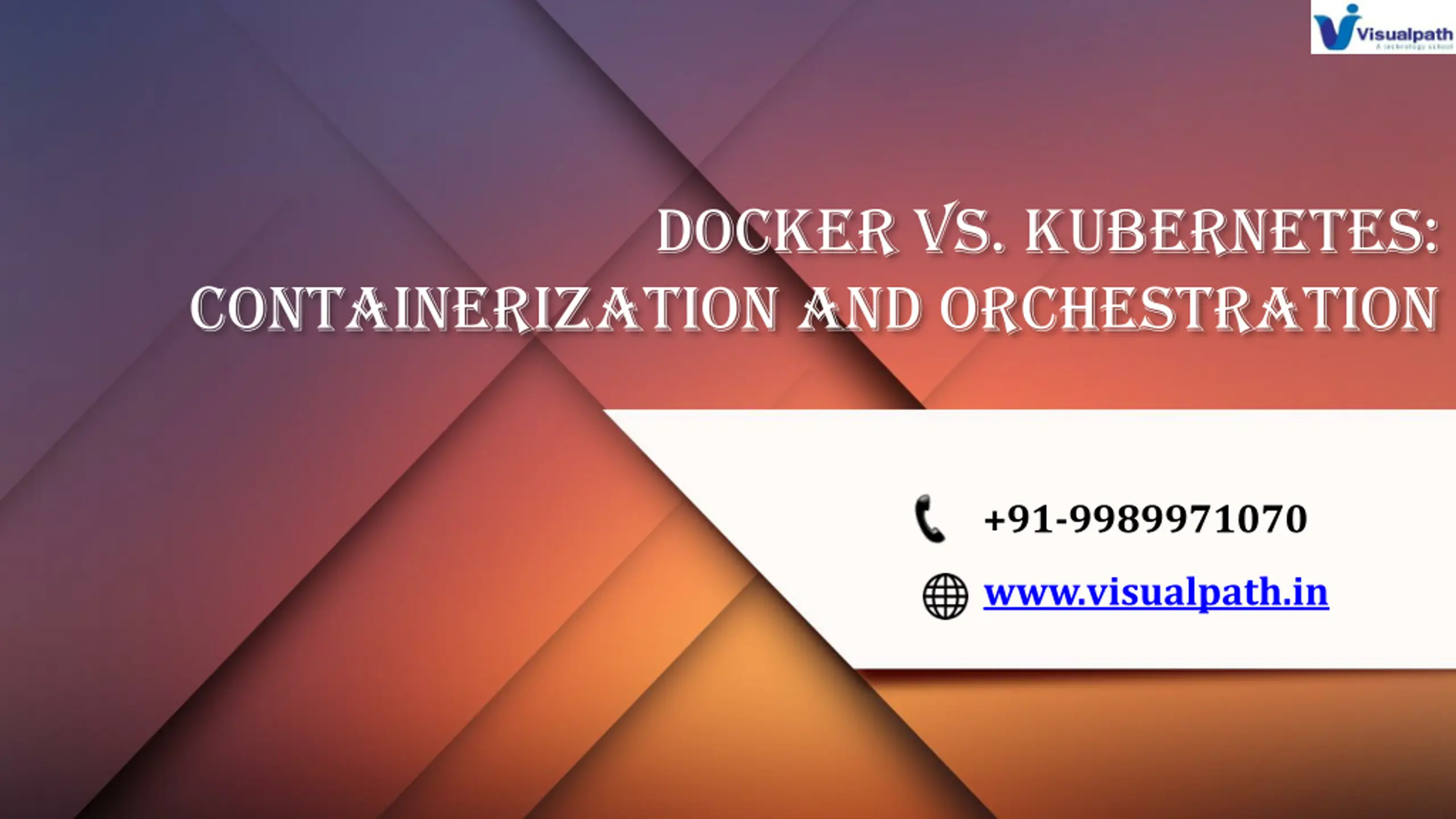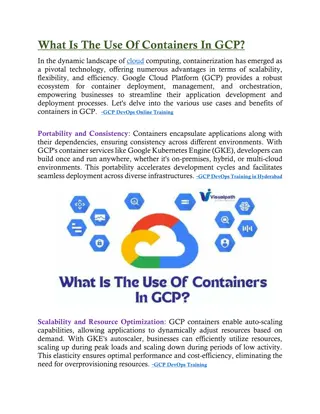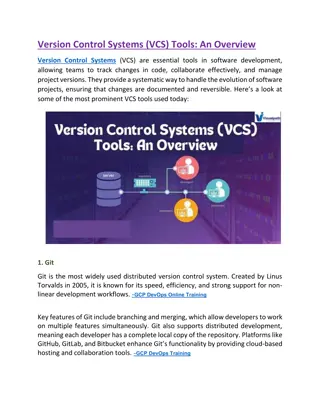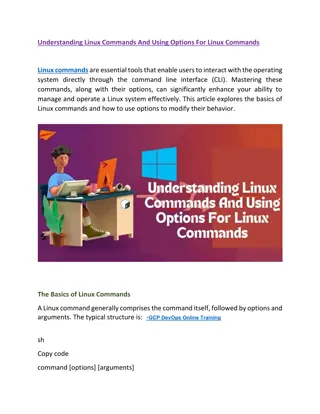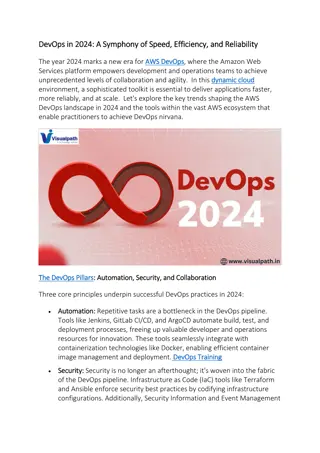DevOps Training | DevOps Online Training
DevOpsTrainingOnline-Visualpath provides top-quality DevOps online training conducted by real-time experts. Our training is available worldwide, and we offer daily recordings and presentations for reference. Enroll with us for a free demo call us at 91-9989971070 nWhatsApp: https://www.whatsapp.com/catalog/919989971070 nVisit Blog: https://awsdevsecopsonlinetraining.blogspot.com/nVisit : https://www.visualpath.in/devops-online-training.htmln
Download Presentation

Please find below an Image/Link to download the presentation.
The content on the website is provided AS IS for your information and personal use only. It may not be sold, licensed, or shared on other websites without obtaining consent from the author.If you encounter any issues during the download, it is possible that the publisher has removed the file from their server.
You are allowed to download the files provided on this website for personal or commercial use, subject to the condition that they are used lawfully. All files are the property of their respective owners.
The content on the website is provided AS IS for your information and personal use only. It may not be sold, licensed, or shared on other websites without obtaining consent from the author.
E N D
Presentation Transcript
Docker vs. Kubernetes: Containerization and Orchestration +91-9989971070 www.visualpath.in
Introduction In the world of modern application development, containerization has enhancing scalability, portability, Docker and Kubernetes technologies that play pivotal roles in this ecosystem, each addressing distinct aspects of the containerized application lifecycle. Let's explore the key differences between Docker and Kubernetes. become cornerstone, and efficiency. two powerhouse a are www.visualpath.in
Docker: Containerization Simplified Docker Basics: Docker is a platform that simplifies the process of creating, deploying, and running applications in containers. Containers encapsulate an application and its dependencies, ensuring consistency across various environments. Docker enables developers to package their applications with all required libraries and dependencies, creating lightweight, portable, and self- sufficient containers. www.visualpath.in
Key Features: Container Images: Docker uses images as the building blocks of containers. Images are lightweight, standalone, and contain everything needed to run an application, including code, runtime, libraries, and system tools. Docker Engine: The Docker Engine is the core component responsible for building and running containers. It provides a command-line interface and a REST API for managing containers. Docker Compose: Docker Compose is a tool for defining and running multi-container Docker applications. It uses a YAML file to configure application services, networks, and volumes, streamlining the applications. deployment of complex www.visualpath.in
Docker Use Cases: Docker is primarily used for packaging and distributing applications, ensuring consistent runtime environments across various stages of the development lifecycle. It excels in scenarios where a lightweight and portable deployment solution is needed, such as microservices architectures development environments. or isolated www.visualpath.in
Kubernetes: Orchestrating Containerized Applications Kubernetes Basics: While Docker focuses on containerization, Kubernetes extends providing a powerful orchestration platform for managing containerized applications. Kubernetes automates the deployment, scaling, and operation containers across clusters of hosts. its capabilities by of application www.visualpath.in
Key Features: Container Orchestration: Kubernetes orchestrates the deployment, scaling, and management of containerized applications. It ensures that the desired state of the application matches the actual state, automatically handling tasks like load balancing, rolling updates, and fault tolerance. Pods and Nodes: Kubernetes introduces the concept of pods, which are the smallest deployable units in the Kubernetes object model. Nodes are the underlying infrastructure where pods run. www.visualpath.in
Service Kubernetes provides built-in mechanisms for service discovery and load balancing, ensuring that applications remain accessible and available even as they scale. Configurations and Secrets: Kubernetes allows the definition of configurations and secrets separately from the application code, enhancing security and enabling dynamic configuration updates. Discovery and Load Balancing: www.visualpath.in
Kubernetes Use Cases: Kubernetes is ideal for managing complex, distributed applications microservices. It excels in scenarios where high availability, scalability, management of containerized workloads are crucial. Kubernetes is particularly valuable for deploying applications environments where tolerance are paramount. with multiple and automated in production and reliability fault www.visualpath.in
Choosing Between Docker and Kubernetes: The choice between Docker and Kubernetes depends on the specific requirements of the project. If the primary need is for containerization and simplicity in managing individual containers, Docker alone may suffice. However, for complex, production-grade deployments involving multiple containers, services, and scaling considerations, Kubernetes emerges as the preferred choice, offering robust orchestration capabilities. www.visualpath.in
Conclusion In summary, while Docker and Kubernetes are often used together, they address distinct aspects of the containerization simplifies the packaging and deployment of applications in containers, orchestrates and manages these containers at scale, providing a comprehensive solution for deploying and scaling containerized workloads in production environments. ecosystem. Docker while Kubernetes www.visualpath.in
Slide Title CONTACT For More Information About DevOps Online Training Address:- Flat no: 205, 2nd Floor, Nilagiri Block, Aditya Enclave, Ameerpet, Hyderabad-16 Ph No : +91-9989971070 Visit : www.visualpath.in E-Mail : online@visualpath.in
THANK YOU Visit: www.visualpath.in
